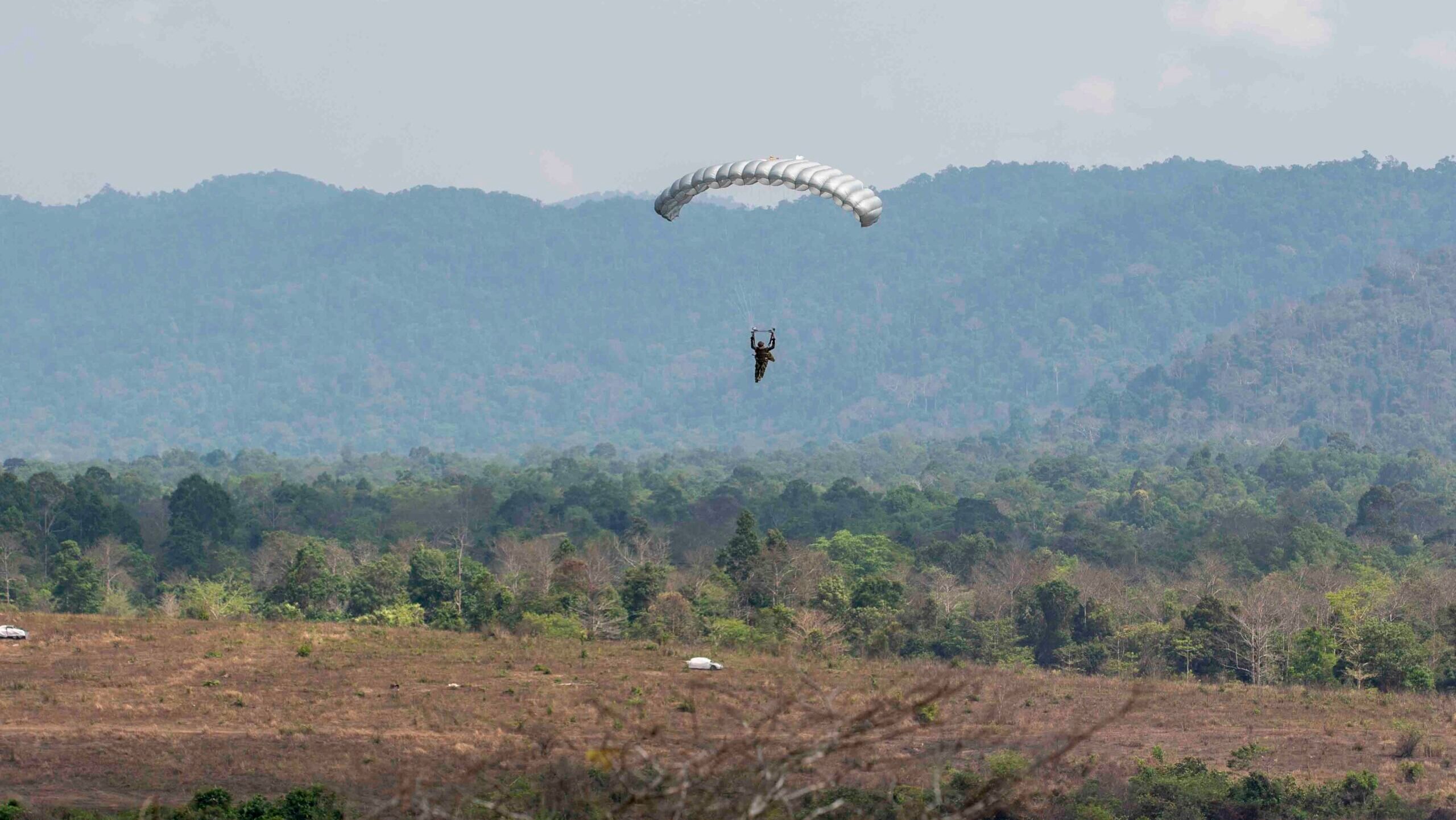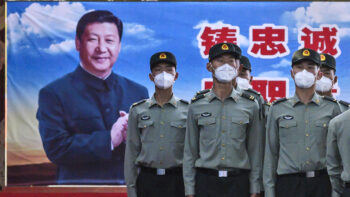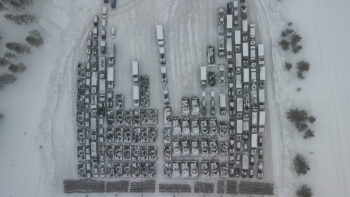
A Royal Thai Marine parachutes onto a landing zone while participating in a combined arms live-fire exercise during Exercise Cobra Gold in Chanthaburi province, Thailand, March 8, 2024. (US Marine Corps photo by Sgt. Patrick Katz)
BANGKOK — On March 1, some 2,200 US, Thai, and South Korean troops and dozens of aircraft, ships, and vehicles were assembled on and over the Gulf of Thailand. The goal: to pull of a massive, simulated amphibious assault, moving forces from ship to shore as quickly and effectively as possible, as part of the annual Cobra Gold exercise.
The inclusion of amphibious skills in the exercise, Asia’s largest defense exercise, isn’t new. But officials at the exercise and outside analysts all agree that this particular skill set is one that is of increasing demand in the region — both because of concerns about Chinese territorial impingements, and for disaster response reasons.
“For the Marines, many of them it’s their first time, so our ability to do this over and over again and give multiple levels of experience from the Marines’ perspective and apply that with partners — every single time it might be new, but then that lance corporal that some day is a staff sergeant, that lieutenant that some day is a colonel, they can come back and remember” the experience, Col. Sean Dynan, commander of the 15th MEU, told media at the event.
“It’s a skill set that is perishable if you don’t practice it routinely, and we need to practice all of our skill sets,” Rear Adm. Christopher Stone, commander of the US Navy’s Task Force 76/3, added. “It’s a matter of when, not if, a humanitarian crisis will emerge. We have to practice that routinely. We need to practice everything from response to civic action all the way up to major combat operations and everything in between.”
During the exercise, the first to arrive ashore were members of the 15th Marine Expeditionary Unit’s Reconnaissance Company, who parachuted into a mock village at a Thai military training area at Hat Yao Beach.
They were followed by US, Thai, and South Korean Marines who sprinted to the beach aboard rubber raiding craft ahead of the main force. US F-16s and Apache helicopters then conducted simulated airstrikes as landing craft approached the shore, supported by CH-53 and UH-1 helicopters and a more distant P-8 patrol plane.
Thai and South Korean amphibious assault vehicles soon hit the beach, disgorging dozens of Marines who raced inland, firing blank rounds at an imagined enemy. US hovercraft — launched from the amphibious transport dock USS Somerset and expeditionary mobile base USS Miguel Keith — followed the AAVs ashore to unload light armored vehicles. As the Apaches circled, other landing craft brought in more armored vehicles, including a South Korean self-propelled howitzer.
Cobra Gold, now in its 43rd year, included 30 countries, seven of them full participants, and more than 9,000 personnel, making it the largest defense exercise in Asia and the longest-running in the world, said Stone. Dynan said Cobra Gold had always been large but had grown from “mostly bilateral” in 2002, when he last took part, into a major multinational event.
The scale and complexity was visible in the amphibious drill, where “you have three different nations landing on the same beach near-simultaneous and both working through language barriers but also just using tactical control measures” to ensure troops got ashore safely and effectively, Dynan said, speaking alongside Stone.
Stone and Dynan both pointed to communications as an area of focus. Stone, who oversees amphibious operations for the Navy’s 7th Fleet, said planners set up three sea lanes to the beach “so we can deconflict forces and we can work together even if we don’t speak the same language.”
Marines also practiced “partner communication” between landing craft and ships during the drill, “which is something we’re always trying to grow and work through,” Dynan said. “We’ve actually built out a capability with Marines that go aboard either ships or on the craft — not just [a liaison officer] with a radio but something different where they’ll actually talk to one another, which is unique.”
This year’s Cobra Gold was also the first to have a Common Operating Picture, which Stone described as “a fused, common, shared picture of the battlespace” for all forces involved.
Setting up the COP took years of work on information-sharing agreements and technological compatibility, which was needed so they could “fuse information” to “understand what’s occurring in the air, what’s occurring on the surface, and perhaps the undersea as well so you can use that information together,” Stone said.
Amphib Forces For Conflict And Crisis
Countries across Asia have been developing amphibious forces for some time, though they have faced budget constraints and shifting priorities.
“In a big-picture sense, maritime security has become more high profile around the world after many years of a focus on mostly terrestrial counter-terrorism, and we’re seeing renewed interest globally in amphibious forces,” said Walker Mills, a US Marine Corps infantry officer and former nonresident fellow at the Marine Corps University’s Brute Krulak Center for Innovation and Future War.
In the Asia-Pacific in particular, recent maritime developments have “increased the attraction and importance of amphibious capabilities,” Nick Childs, senior fellow for naval forces and maritime security at the International Institute for Strategic Studies, told Breaking Defense.
“Increased regional tensions have been stimulating a number of countries to beef-up their amphibious capabilities, led most notably by China,” Childs added, noting Beijing’s emphasis on rapidly expanding its ability to ferry troops from sea to shore. China’s growing amphibious fleet and expanding Marine Corps, in turn, is driving nations to invest in similar capability.
Japan, wary of Chinese activity near its islands around the East China Sea, has stepped up its training with US amphibious forces over the past decade. In 2018, Tokyo established its first Marine unit since World War II, the Amphibious Rapid Deployment Brigade. The brigade partners closely with the US Marine Corps, most recently in the annual Iron Fist exercise, which for the second year in a row included training to seize islands off of southwestern Japan.
The Australian Defense Force is also adjusting to “a new strategic environment” and focusing on being able to operate along its northern approaches. Among the needs listed in Australia’s 2023 Defense Strategic Review was “a fully enabled, integrated amphibious-capable combined-arms land system,” and the ADF is restructuring several combat brigades for amphibious and littoral operations. Australia has deepened its amphibious training with the US and others, holding its first amphibious exercise with the Philippines last summer.
The Philippines is also shifting its military focus, adopting a new Comprehensive Archipelagic Defense Concept oriented toward defense against external attack, an objective visible in recent exercises along its northern and western coasts.
Many countries in the region are also investing in amphibious forces to be better prepared for natural disasters and other emergencies. Childs said the increased significance of humanitarian assistance and disaster relief missions is “driving demand for various types of amphibious capability, which have considerable utility in such circumstances,” though those are distinct mission sets “and will drive different approaches to force design and training depending on countries’ priorities.”
The humanitarian assistance and disaster relief training provided by Cobra Gold has already been put to real-world use — including after the 2004 Indian Ocean tsunami, the 2011 earthquake and tsunami in Japan, and Typhoon Haiyan in the Philippines in 2013 — and it has only expanded over the years.
“Our ability across multiple nations to do humanitarian assistance/disaster relief, that was not something that we did back in 2002,” Dynan said. “Now it’s expanded, I think, to match reality, which is when are the most likely situations that we’re going to operate together — it might eventually be in something like combat but the most likely thing that’s going to occur anywhere in the world at any given time is something that requires somebody to be somebody’s hero.”
US Marines Still The World Leader
The US Marine Corps remains the world’s largest and most capable amphibious force, and many countries with similar units “look to the US for cues on how to evolve and mature their forces,” Mills said.
Some of those forces are tracking the Corps’ Force Design 2030, a redesign meant to make Marine units lighter, more mobile, and capable of dispersing in littoral areas within range of enemy weapons. As part of that effort, it has shed “big, heavy things” like tanks and tube artillery and is developing new units, hardware, and training. Corps leaders say the goal is to maintain a crisis-response capability while modernizing, and Mills said the service has the assets needed to do a range of amphibious operations, such as assaults or raids, but there are questions about scale and readiness.
One Amphibious Ready Group-Marine Expeditionary Unit formation, composed of three ships carrying Marines, vehicles, and aircraft, “should be capable of all of those operations,” Mills told Breaking Defense, “but that’s only about 2,000 Marines. If we were planning an amphibious assault against an adversary we’d want a force several times that size. Could we call that up? I’m not sure.”
A major concern is the US Navy’s 31-ship amphibious fleet, which faces availability issues and is set to shrink. Plans to build more are in doubt, raising concerns about the Corps’ ability to respond to crises around the world.
Mills said the Corps needs no fewer than “and probably needs more” than 31 amphibious ships, and it will “absolutely need” the new class of smaller amphibious vessels that the Navy plans to build, which are meant to support dispersed operations in littoral areas.
The Marine Corps commandant’s latest guidance, published this month, says the Corps will “staunchly advocate” for “the greatest possible readiness” of current amphibious ships, for having “no fewer than 31” amphibious ships, and for “timely production” of 35 smaller amphibious vessels.
Christopher Woody is a defense journalist based in Bangkok. You can follow him on Twitter and read more of his work here.























